Olympic Art Competition
| The Art Competition
General Preparations The insertion of an art competition into the programme of the Olympic Games-a special wish of their reviver, Baron Pierre de Coubertin—has placed upon the Organizing Committees of the different festivals the mission of emphasizing to an increasing degree the intellectual and cultural aspects in addition to the physical and sporting in making their preparations. A considerable period of time was required, however, before the artists of the world could be convinced of the necessity and the object of such a mission, or before they recognized the close connections between art and sport clearly enough to find in sport a suitable inspiration for their creations and artistic forms. Following the Stockholm Olympic Games of 1912, at which the first art competition was held, the organizers of each Festival endeavoured to fulfil their obligations in this field in a satisfactory manner, and the Organizing Committee for the Eleventh Olympic Games, Berlin, 1936 was confronted with the task of continuing this development and of arranging an art competition and exhibition which would be in keeping with the significance of the Games. The preliminary questions pertaining to this project were considered immediately after the close of the Los Angeles Games, and preparatory work of a general nature was begun. It was necessary first of all to find capable and influential personages for the Olympic Art Committee, and the former Reich Inspector of Art was called upon to head the Committee, the other members being selected with his assistance from the different art circles in Germany. The National Socialist Revolution necessitated many changes in this entire field, however, and indicated the lines of development to be followed in the final formation of the Olympic Art Committee. At the wish of the Reich Minister of Propaganda, a representative of this Ministry was appointed Chairman of the Art Committee. Herr Weidemann held this post temporarily from November, 1933 till March, 1934, after which he was replaced by Government Councillor Kurt Biebrach, who accepted the post in August, 1934. For purposes of efficiency an attempt was made from the very beginning to limit the membership in the main and sub-committees as much as possible. The principal committee was composed of representatives of the different departments, members of the various individual groups in the Reich Chamber of Fine Arts, outstanding German artists, representatives from the museums and delegates from the Organizing Committee. The technical supervision of the Art Department, and in this connection also of the Olympic Art Competition and Exhibition, was placed in the hands of Frau Lobeck, and the members of the active committees for the different fields of art were selected upon the recommendation of the respective branches of the Reich Chamber of Culture. The principal committee, which in the course of time underwent several changes, was finally composed of the following personages:
Government Councillor Kurt Biebrach, Chairman, Reich Ministry of
Propaganda Since the members of the active committees would also be called upon to serve as German judges on the international jury, they had to be selected with this end in view. The members generously contributed their time and ability to this none too simple task in spite of the numerous other matters demanding their attention. The first task was the compilation of the general regulations for the Olympic Art Competition, these in their original form having undergone several fundamental and textual revisions, At the special wish of the German representatives in Section II (painting), this department was divided into two subsections, painting and graphic arts, while Group D (commercial art), consisting of placards, diplomas, stamps and signets, was added to Group C (graphic arts) comprising wood-cuts, copperplate engravings, etchings and lithographs. Section III (sculpture) was also given a new sub-section through the removal of reliefs from Group B and medals from Group C. Since this extension involved the awarding of an increased number of victors’ medals, the approval of the International Olympic Committee had to be obtained. This was granted in connection with the Congress of the International Olympic Committee at Oslo in February, 1935, when the Executive Committee of the International Olympic Committee approved the regulations without making any changes. Source document: Official Report 1936, Vol. 2, page 1106 ff |
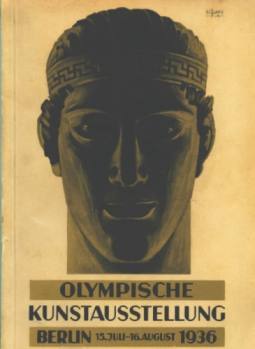
Catalog of the Olympic Art Competition 1936 Berlin
The prizes were awarded as follows:
ARCHITECTURE
Architectural Designs:
| 1936 | 1st | Hermann Kutschera | AUT | Skiing Stadium |
| 2nd | Werner March | GER | Reich Stadium | |
| 3rd | Herbert Kastinger + | AUT | Vienna Racing Courses | |
| Hermann Stiegholzer |
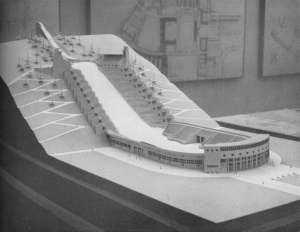
Skiing Stadium, Hermann Kutschera
Designs for Town Planning:
| 1936 | 1st | Werner March and | GER | Reich Stadium |
| Walter March | ||||
| 2nd | Charles Downing Lay | USA | Marine Park in Brooklyn | |
| 3rd | Theodor Nußbaum | GER | Köln Town Plan and Sport Establishments |
SCULPTURE
Medals:
| 1936 | 1st | no prize was awarded | ||
| 2nd | Luciano Mercante | ITA | Medals | |
| 3rd | Jozue Dupon | BEL | Rding Plaques |
Relief's:
| 1936 | 1st | Emil Sutor | GER | Hurdle Runners |
| 2nd | Jósef Klukowski | POL | Football | |
| 3rd | no prize was awarded |
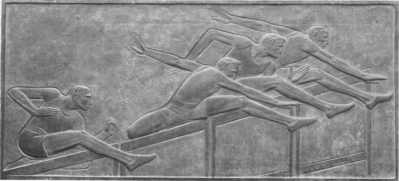
Hurdle Runners, Emil Sutor
Sculpture:
| 1936 | 1st | Farpi Vignoli | ITA | The Sulky Driver |
| 2nd | Arno Breker | GER | Decathlonist | |
| 3rd | Stig Blomberg | SWE | Wrestling Children |
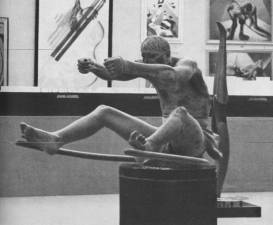
Sulky Driver, Farpi Vignoli
PAINTINGS AND GRAPHIC ART
Applied Graphics:
| 1936 | 1st | Alex Walter Diggelmann | SUI | Poster "Arosa I" |
| 2nd | Alfred Hierl | GER | International Avus Race | |
| 3rd | Stanislaw Ostoja-Chrostowski | POL | Yachting Club Charter |
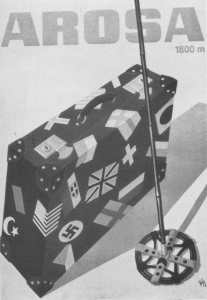
Poster "Arosa I", Alex Walter Diggelmann
Drawings and Water-Colors:
| 1936 | 1st | no prize was awarded | ||
| 2nd | Romano Dazzi | ITA | Four Fresco Patterns | |
| 3rd | Shujaku Suzuki | JPN | Classic horse race in Japan |
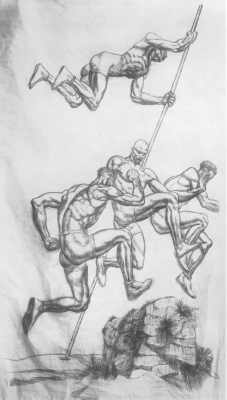
Four Fresco Petterns, Romano Dazzi
Paintings:
| 1936 | 1st | no prize was awarded | ||
| 2nd | Rudolf Herman Eisenmenger | AUT | Runner in the Finish | |
| 3rd | Tsuguharu Fujita | JPN | Ice Hockey |
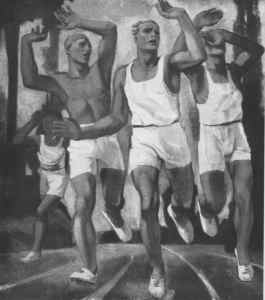
Runner, Rudolf Herman Eisenmenger
Epic Works:
| 1936 | 1st | Urho Karhumäki | FIN | Into Free Water |
| 2nd | Wilhelm Ehmer | GER | Around the Peak of the World | |
| 3rd | Jan Parandowski | POL | The Olympic Discus |
Lyrics:
| 1936 | 1st | Felix Dhünen-Sondinger | GER | The Runner |
| 2nd | Bruno Fattori | ITA | Azzurri Faces | |
| 3rd | Hans Helmut Stoiber | AUT | The Discus |
Compositions for Orchestra of All Kinds:
| 1936 | 1st | Werner Egk | GER | Festive
Music for the Olympiad |
| 2nd | Lino Liviabella | ITA | The Victor | |
| 3rd | Jaroslav Kricka | TCH | Mountain Melodies |
Compositions of Songs for Soloist or Choir,
with or Without Instrumental Accompaniment:
| 1936 | 1st | Paul Höffer | GER | Olympic Oath |
| 2nd | Kurt Thomas | GER | Cantata for the 1936 Olympiad | |
| 3rd | Harald Genzmer | GER | The Runner |
Merit for Aeronautics:
| 1936 | 1st | Hermann Schreiber | SUI | Gliding Flight over the Alps |
Merit for Alpinism:
| 1936 | 1st | Hettie Dyhrenfurth and | SUI | Himalaya Expedition of |
| Günter Oskar Dyhrenfurth | 1930 and 1931 |